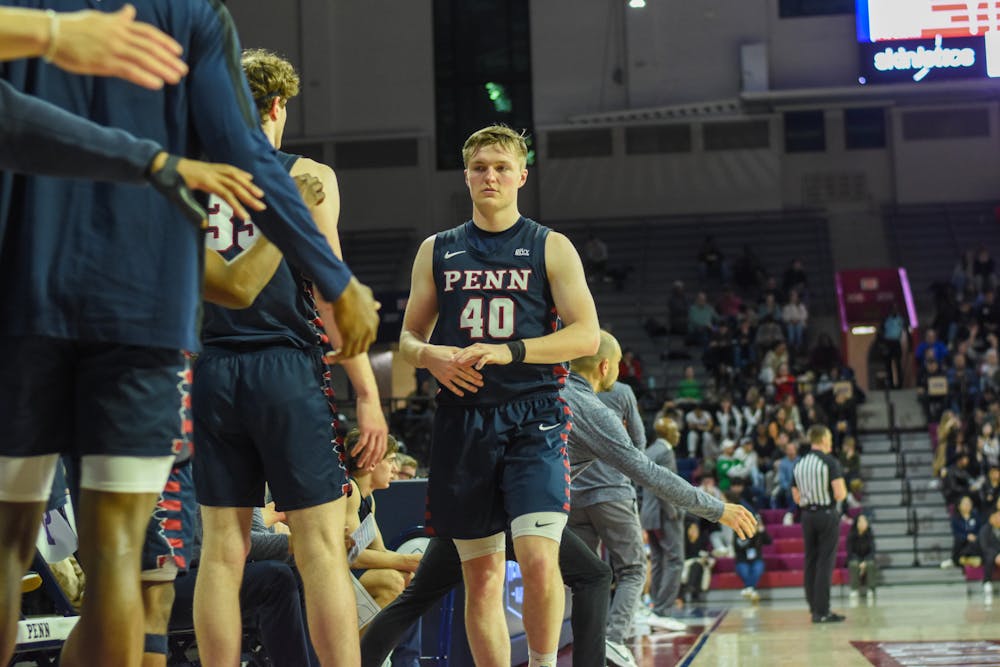
After entering the weekend tied for fourth place in the conference table, Penn men’s basketball dropped back-to-back home games to Brown and Yale and now sits on the outside looking in of the conference tournament picture.
Let’s break down the key takeaways from a disappointing weekend and what they mean for the Quakers moving forward.
‘40 minutes of trust and belief’
Many of Penn men’s basketball coach Steve Donahue’s critiques following Penn’s losses this season have boiled down to the team’s struggle to log a “full 40 minutes.” That was especially true over the weekend, when the Quakers’ continual ups and downs stood in the way of a victory.
The Quakers limped out of the gate in both contests, with Brown’s hot shooting and Yale’s smothering defense leading to first-half deficits of 16 or more points in both games. Against Brown, Penn trimmed the lead to 10 at halftime before opening the second half on a 12-0 run to take back the lead. Then, after leading 72-69 with six and a half minutes to play, the Quakers gave up a 14-2 run to seal the defeat.
Penn’s clash with Yale was never close, but the Red and Blue still showed flashes of solid play. After falling behind early, a stretch of hot shooting helped the Quakers cut the deficit to seven with four and a half to go in the first half. Then, after trailing by 16 at the break, Penn outscored Yale 23-21 in the first 15 minutes of the second half.
Putting together a complete effort is easier said than done, but Donahue believes his team has what it takes.
“We should try to be more consistent with the 40 minutes,” Donahue said. “We don’t have that yet, and that’s what we’re working at: 40 minutes of trust and belief in each other.”
Three-point shooting needs support
Donahue’s offense is one predicated on generating open looks from beyond the arc. The Quakers have found success doing just that this season, hitting 10 or more threes in four straight games, including 18 against Columbia last Saturday to break the program record for triples against a Division I team.
“[It's] scary to watch how they’re running offense,” Brown coach Mike Martin said of Penn’s shooting.
But over the weekend, the Red and Blue were unable to supplement their three-point success. Against the Bears, the Quakers converted 41.2% of their long-range looks to the tune of 14 made threes, but were outdone by a Bears team that nailed 15 on 62.5% from beyond. While Penn’s shooting regressed against the Bulldogs, their 10 threes on 32% shooting were still their most reliable form of offense in a game that saw the Quakers outscored 42-22 in the paint.
While the Quakers’ 40% three-point shooting in conference play gives them the ability to compete with anyone, their fifth-ranked overall scoring offense and seventh-ranked scoring defense will need to improve.
Limiting opposing stars
Facing the conference’s two leading scorers on back-to-back nights is a tall task for any team, but the Quakers did little to limit Brown guard Kino Lilly Jr. and Yale guard John Poulakidas, both of whom scored 21+ points on 50% shooting or better. Lilly was especially successful, scoring a career-high 34 points on 8/9 shooting from three to lead Brown to a win.
Against Lilly, it was a matter of agility — the 2024 first-team All Ivy selection moved fluidly without the ball and decisively with it, generating just enough space to fire off his three-point barrage. Against Poulakidas, it was a matter of size — at 6-foot-6 with a plus-wingspan, Poulakidas had an instant advantage over Penn’s guards (freshman AJ Levine is six feet tall, while sophomore Sam Brown is 6-foot-3) and used it to get off jumpers and capitalize on drives.
Both star guards were quieter in the second half — Lilly shot just 2/7 and made one triple after halftime, while Poulakidas added four points on 1/5 shooting. But by that point, the Quakers had already fallen into double-digit holes in both games.
With Princeton’s Xaivian Lee on the calendar for next Friday and additional matchups with Poulakidas and Lilly to follow, learning to limit opposing guards will be critical for the Quakers’ Ivy Madness hopes.
The playoff picture
At 2-4 in league play, Penn is now tied with Harvard and Brown for fifth place in the conference standings, with all three trailing fourth place Dartmouth by a single game. While the league’s top three — Yale, Cornell, and Princeton — seem to have distinguished themselves from the pack, the Quakers are still very much in the running for the tournament’s fourth and final seed.
The Red and Blue play Princeton on Friday to finish out their first round-robin of Ivy League games before flipping the calendar to the second half of the slate. It’s worth noting that after a four-game homestand, Penn will play five out of its final seven games on the road, including trips to New Haven, Ithaca, and Princeton.
At 2-4, Penn still has room for error, but the margin decreases with each passing game.
“These are playoff games to get into the tournament,” Donahue said.
The Daily Pennsylvanian is an independent, student-run newspaper. Please consider making a donation to support the coverage that shapes the University. Your generosity ensures a future of strong journalism at Penn.
Donate



